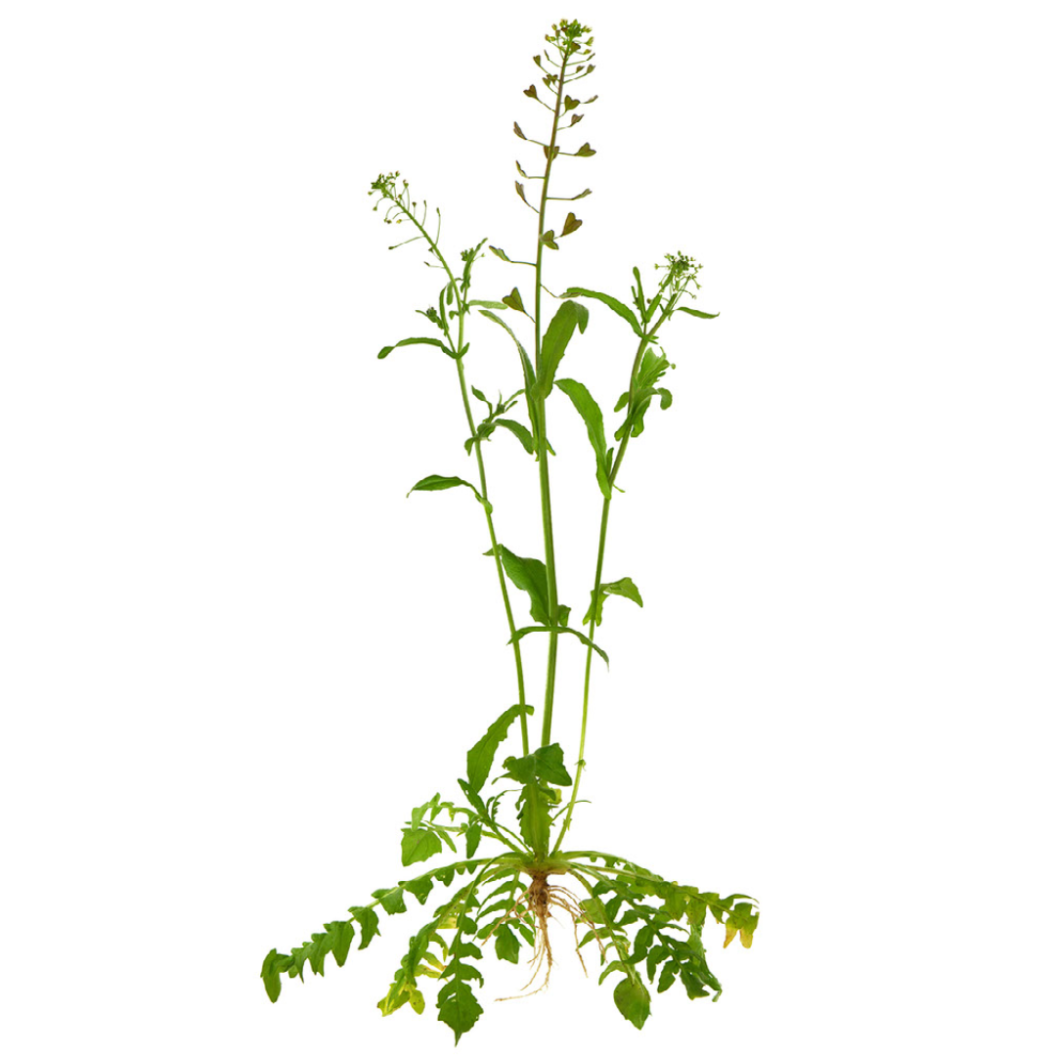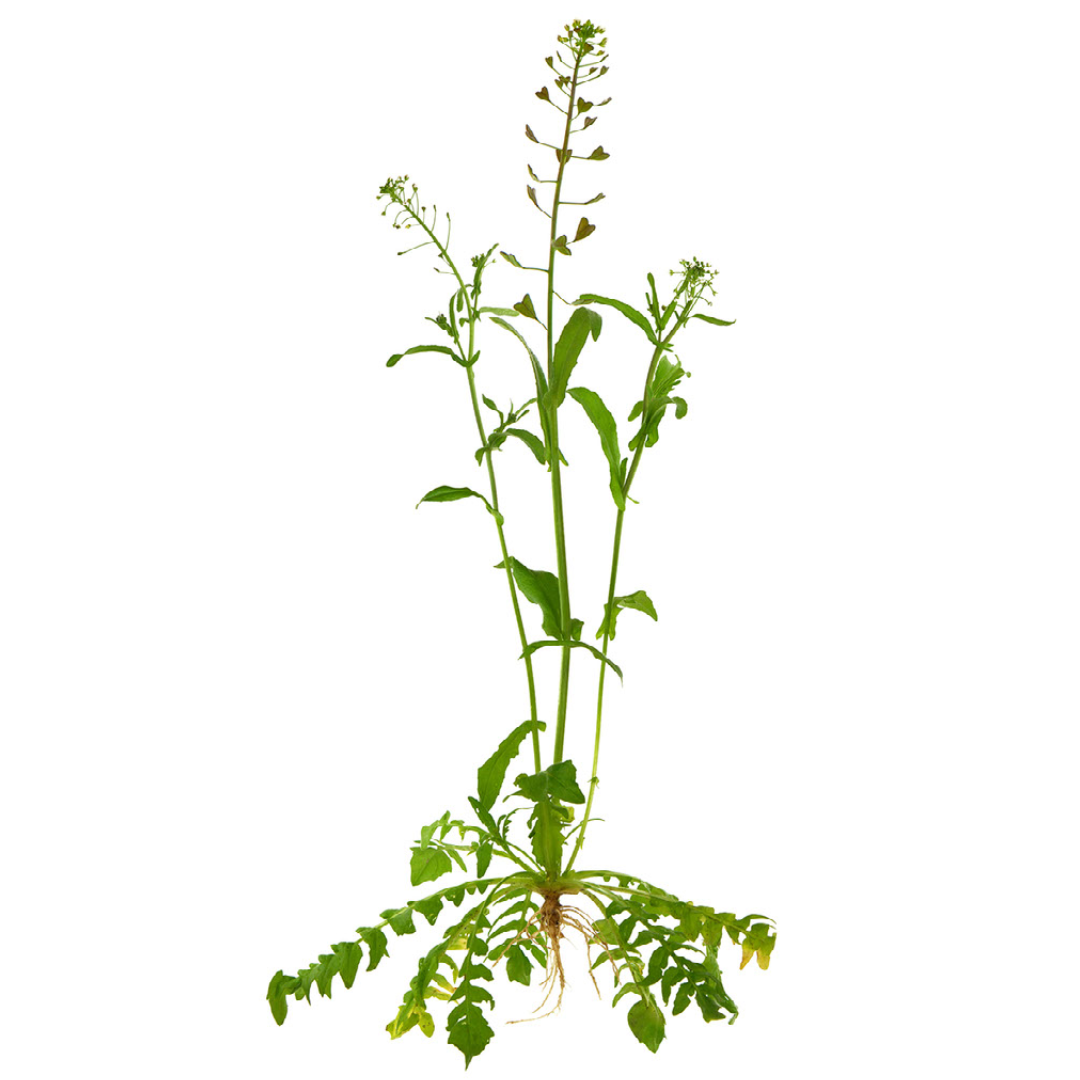
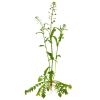
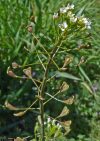

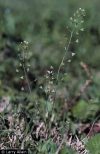
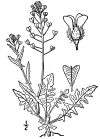
Shepherd’s Purse
DESCRIPTION: Shepherd's purse is a type of weed that is commonly found in gardens, fields, and other open spaces. It has small, white flowers and distinctive seed pods that are shaped like tiny purses, hence the name. Despite being a weed, shepherd's purse is actually edible and has been used for centuries in herbal medicine to treat a variety of ailments. Some people even use it as a food ingredient, adding the leaves or seeds to salads, soups, and other dishes.
SCIENTIFIC NAME: Capsella bursa-pastoris
OTHER NAMES: Mother's Heart, Shepherd's Pouch, Pickpocket, Pepper-and-Salt
LEAF TYPE: Broadleaf
FLOWERS: Shepherd's purse has small, delicate flowers that are usually white in color. Each flower has four petals that are arranged in the shape of a cross, giving the flower a slightly star-like appearance. The petals are usually shorter than the seed pods and are held up on thin, wiry stems. When the flowers first appear, they are tightly closed and look like tiny buds, but as they mature, the petals open up and the flower takes on a more distinct shape. Overall, the flowers are quite pretty and add a touch of charm to an otherwise unremarkable weed.
LEAVES: Shepherd's purse leaves are long and narrow, with a slightly jagged or toothed edge. They have a bit of a spiky appearance, like the edge of a saw blade, but are still relatively soft to the touch. The leaves grow in a rosette shape close to the ground, with the younger leaves located in the center and the older ones radiating outwards. The color of the leaves is a medium to dark green, with a slightly waxy texture. They are not very large, usually no more than a few inches long, and have a slightly oval or lance-shaped appearance. Overall, the leaves of shepherd's purse are simple but attractive in their own way.
LIFE CYCLE: Annual
HOW TO IDENTIFY: Identifying Shepherd's purse is relatively easy. Look for a low-growing plant with a rosette of long, narrow leaves that have a slightly spiky appearance. The leaves grow close to the ground and are usually a medium to dark shade of green. In the spring and early summer, the plant produces small, delicate white flowers with four petals that are arranged in a cross shape. These flowers give way to distinctive seed pods that are shaped like tiny purses, giving the plant its name. The seed pods are usually arranged in a long, narrow cluster along a single stem that rises above the leaves.
MECHANICAL CONTROL RECOMMENDATIONS:
1. Hand pulling - More Info
2. Mowing or Cutting - More Info
3. Tilling or Cultivating - More Info
4. Mulching - More Info
5. Flaming - More Info
6. Hoeing or Weed Cutting Tools- More Info
7. Weed Eating - More Info
8. Bio Mulching - More Info
9. Crop Rotation - More Info
CHEMISTRY RECOMMENDATIONS:
"Pre-emergent herbicides:
Prodiamine: Effective against a variety of broadleaf weeds and grasses. It's commonly used in lawns, turfgrass, and ornamental landscapes.
Dithiopyr: Provides pre-emergent control against both annual grasses and some broadleaf weeds. Suitable for use in lawns and ornamental areas.
Pendimethalin: Effective against a wide range of annual grasses and many broadleaf weeds. Often used in lawns, gardens, and non-crop areas.
Oryzalin: Controls various annual grasses and broadleaf weeds. Suitable for lawns, landscapes, and gardens.
Isoxaben: Primarily targets broadleaf weeds in ornamental landscapes and gardens.
Trifluralin: Offers pre-emergent control against a range of annual grasses and broadleaf weeds. Used in lawns, gardens, and agricultural crops.
Benefin: Effective against annual grasses and some broadleaf weeds. Used in turfgrass and non-crop areas.
Indaziflam: Provides long-lasting residual control against annual grasses and broadleaf weeds. Used in turf and non-crop areas.
Dimethenamid-P: Controls specific annual grasses and broadleaf weeds. Suitable for turf and ornamental landscapes.
Post-emergent herbicides:
2,4-D: A widely used selective herbicide effective against many broadleaf weeds, including shepherd's purse. It's commonly used in lawns, pastures, and non-crop areas.
Dicamba: Another selective herbicide effective against broadleaf weeds, including shepherd's purse. Often used in combination with other herbicides. Be cautious of drift to non-target plants.
Metsulfuron-methyl: Effective against a variety of broadleaf weeds, including shepherd's purse. Used in lawns, pastures, and non-crop areas.
Triclopyr: Effective on a variety of broadleaf weeds, including woody plants. Used in lawns, pastures, and non-crop areas.
Carfentrazone-ethyl: A quick-acting herbicide effective against broadleaf weeds. Used in turf, landscapes, and non-crop areas.
Sulfentrazone: Controls both broadleaf and grassy weeds, including shepherd's purse. Often used in turf, ornamental landscapes, and non-crop areas.
Fenoxaprop: Primarily targets grassy weeds, but it can also provide some control over broadleaf weeds like shepherd's purse. Used in lawns and turfgrass.
Glyphosate: A non-selective herbicide effective against a wide range of weeds, including shepherd's purse. Used for total vegetation control in non-crop areas.
Selective herbicides:
2,4-D: Widely used for controlling broadleaf weeds, including shepherd's purse. It's commonly used in lawns, pastures, and non-crop areas.
Dicamba: Effective against a variety of broadleaf weeds, including shepherd's purse. Often used in combination with other herbicides.
MCPA: Selective herbicide targeting broadleaf weeds. Used in lawns, pastures, and non-crop areas.
Triclopyr: Effective against a wide range of broadleaf weeds, including woody plants. Used in lawns, pastures, and non-crop areas.
Carfentrazone-ethyl: Quick-acting herbicide effective against various broadleaf weeds, including shepherd's purse. Used in turf, landscapes, and non-crop areas.
Sulfentrazone: Controls both broadleaf and grassy weeds, including shepherd's purse. Often used in turf, ornamental landscapes, and non-crop areas.
Fenoxaprop: Primarily targets grassy weeds, but it can also provide some control over broadleaf weeds like shepherd's purse. Used in lawns and turfgrass.
Clopyralid: Selective herbicide effective against many broadleaf weeds, including some tough ones. Used in turf and non-crop areas.
Non-Selective herbicides:
Glyphosate: One of the most well-known non-selective herbicides. It effectively kills a broad spectrum of plants, including shepherd's purse. It's commonly used for total vegetation control in non-crop areas.
Glufosinate: Another non-selective herbicide effective against a wide range of plants, including broadleaf and grassy weeds. It's often used in non-crop areas and as a desiccant in certain crops.
Diquat: Kills plants on contact and is often used for aquatic weed control. It's not as systemic as glyphosate, so it's generally best suited for spot treatments.
Paraquat: A contact herbicide that rapidly kills plants by disrupting their cell membranes. It's often used for weed control in non-crop areas.
Recommended Prevention
Recommended Control

